
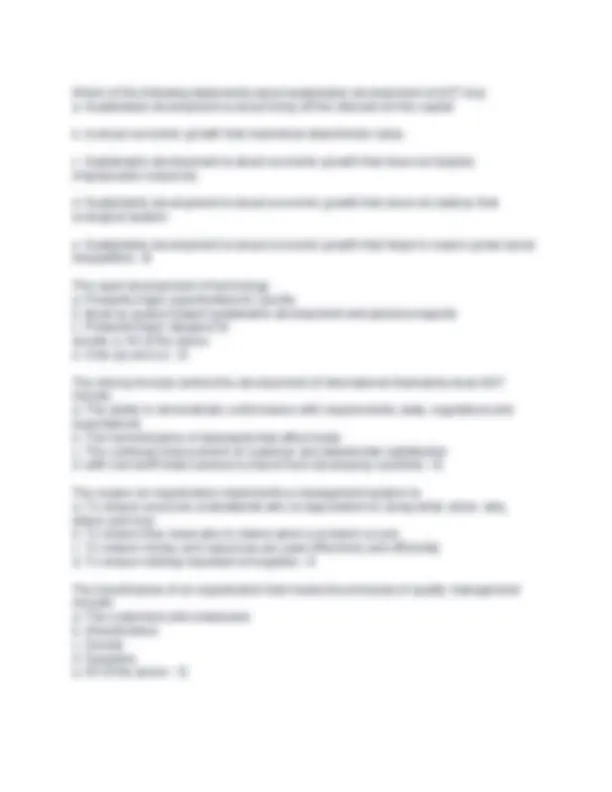
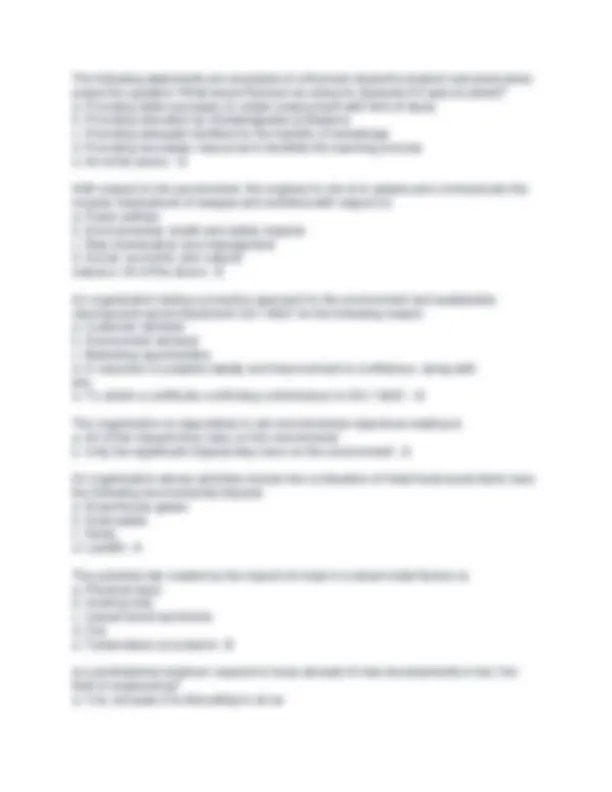
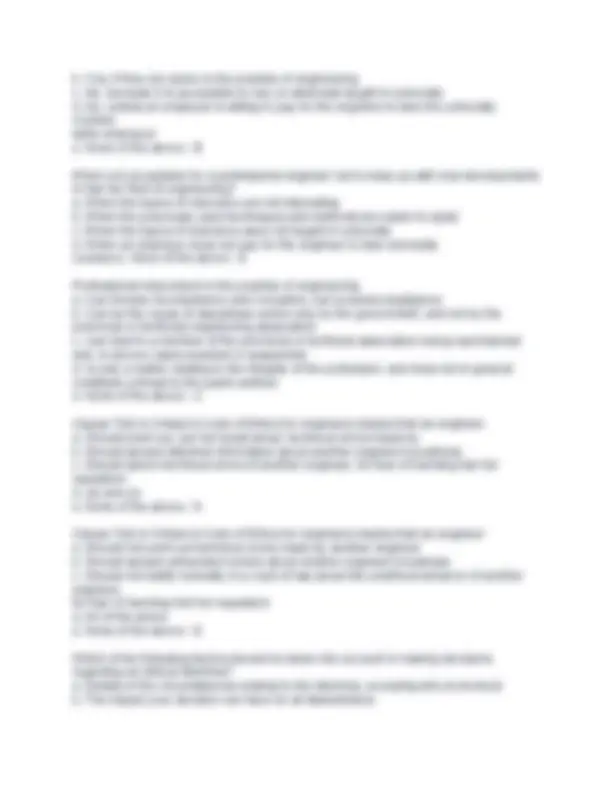
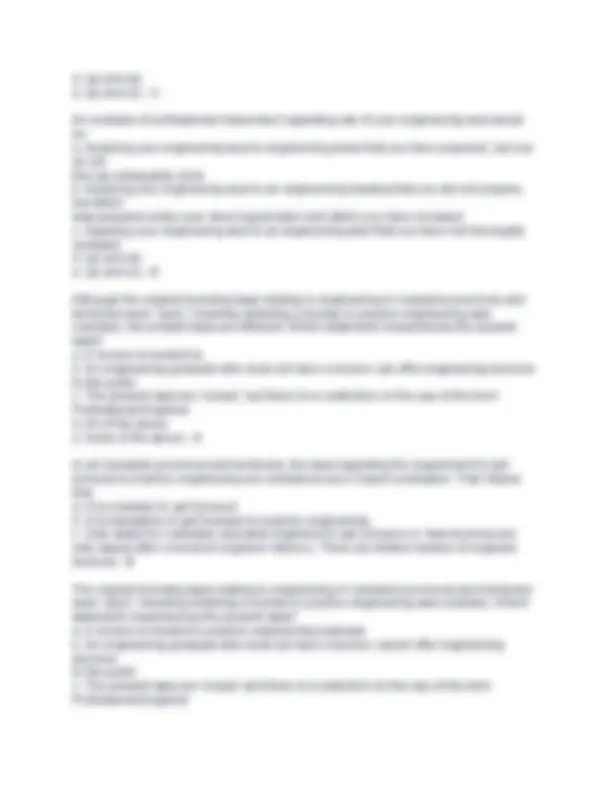
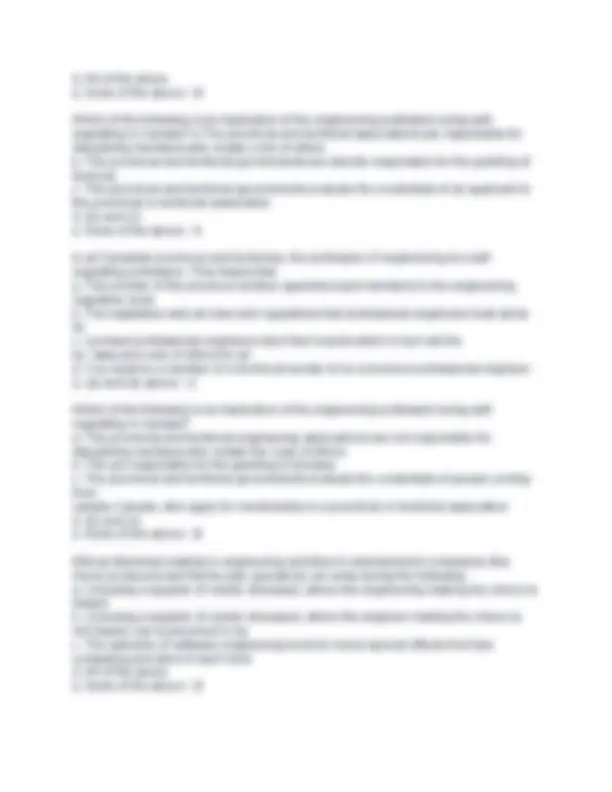
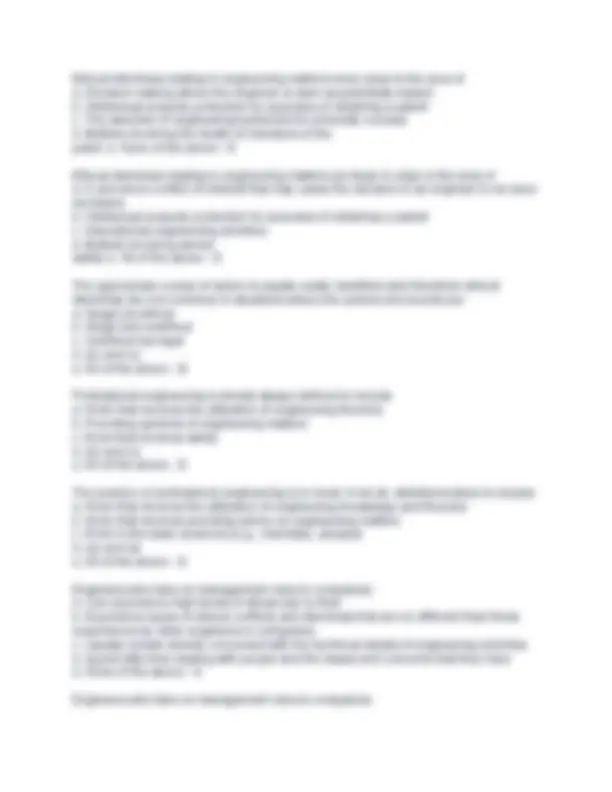


Study with the several resources on Docsity

Earn points by helping other students or get them with a premium plan


Prepare for your exams
Study with the several resources on Docsity

Earn points to download
Earn points by helping other students or get them with a premium plan
Community
Ask the community for help and clear up your study doubts
Discover the best universities in your country according to Docsity users
Free resources
Download our free guides on studying techniques, anxiety management strategies, and thesis advice from Docsity tutors
A series of multiple-choice questions related to ethics in engineering, focusing on professional conduct, environmental responsibility, and compliance with standards and regulations. It covers topics such as sustainable development, the role of engineers in safeguarding public welfare, and the application of iso standards. The questions aim to assess understanding of ethical principles and their practical application in engineering contexts, making it a useful resource for students and professionals in the field. The document also touches on the importance of staying updated with new developments and avoiding professional misconduct. It provides a comprehensive overview of key ethical considerations relevant to engineering practice, promoting critical thinking and ethical decision-making.
Typology: Exams
1 / 11

This page cannot be seen from the preview
Don't miss anything!







Unknowingly failing to comply with laws and regulations is an example of unethical behavior (True or False) - True An engineer who considers the impact that his / her design (either products, processes or services) has on the environment or on employees is acting ethically a. True b. False - True Sustainable development is about incremental change a. True b. False - False Sustainable development is concerned with innovation and organizational renewal a. Tue b. False - True Electronic communications have dramatically decreased human collaboration in every field and between all countries a. True b. False - False International standards, when implemented correctly, contribute to sustainable development and ethical globalization a. True b. False - True A Quality Management System allows an organization to demonstrate its ability to satisfy customers through the provision of products and services that consistently meet customer and regulatory requirements while maintaining a process for continual improvement a. True b. False - True The rapid advancements in science and technology have enabled the environment to absorb unprecedented growth in human activity a. True b. False - False Communities now recognize the need for engineers to use technology to study the impact of human activity on the environment in order to ensure that all development is sustainable a. True b. False - True Ontario is one of the top ten polluters in North America a.True b. False - A
An engineer has an obligation and a responsibility for safeguarding life, health, property and the safety and welfare of the public a. True b. False - A Not every engineering project effects the environment a. True b. False - B Engineers alone can provide the solutions to environmental problems a. True b. False - B The ISO 14001 standard requires an organization to establish and maintain procedures to identify the environmental aspects of its products, services and activities that it can control and over which it can be expected to have an influence a. True b. False - A Engineers are not responsible for knowing which laws and regulations or industry standards relate to what their organization does a. True b. False - F ISO 14001 requires only that an organization have a plan in place for compliance to laws, regulations and standards, not that it be in compliance at the time of its registration audit a. True b. False - False OHSAS 18001 is a health and safety standard developed by the International Organization for Standardization a. True b. False - True All risks are a result of hazards, but not all hazards create risks a. True b. False - A The development voluntary technical standards is an objective of the International Organization for Standardization a. True b. False - A The increase of easier and fairer international trade is an objective of the International Organization for Standardization - True The creation of non-tariff trade barriers through the enforcement of European based standards is an objective of the International Organization for Standardization - True The provision of safeguards for consumers and users is an objective of the International Organization for Standardization - True The development of safer, cleaner and more efficient products and services is an objective of the International Organization for Standardization - True
The following statements are examples of a Ryerson student's desired outcomes when posed the question 'What would Ryerson be doing for students if it was excellent?' a. Providing skills necessary to obtain employment with field of study b. Providing education by knowledgeable professors c. Providing adequate facilities for the transfer of knowledge d. Providing necessary resources to facilitate the learning process e. All of the above - E With respect to the government, the engineer's role is to assess and communicate the broader implications of designs and activities with respect to: a. Public welfare b. Environmental, health and safety impacts c. Risk minimization and management d. Social, economic and cultural values e. All of the above - E An organization taking a proactive approach to the environment and sustainable development would implement ISO 14001 for the following reason: a. Customer demand b. Government demand c. Marketing opportunities d. A reduction in possible liability and improvement in confidence, along with line e. To obtain a certificate confirming conformance to ISO 14001 - D The organization is responsible to set environmental objectives relating to a. All of the impacts they have on the environment b. Only the significant impacts they have on the environment - A An organization whose activities include the combustion of fossil fuels would likely have the following environmental impacts a. Greenhouse gases b. Solid waste c. Noise d. Landfill - A The potential risk created by the hazard of noise in a sheet metal factory is a. Physical injury b. Hearing loss c. Carpal tunnel syndrome d. Fire e. Temperature excursions - B Is a professional engineer required to keep abreast of new developments in his / her field of engineering? a. Yes, because it is interesting to do so
b. Yes, if they are active in the practise of engineering c. No, because it is acceptable to rely on what was taught in university d. No, unless an employer is willing to pay for the engineer to take the university courses while employed e. None of the above - B When is it acceptable for a professional engineer not to keep up with new developments in his/ her field of engineering? a. When the topics of relevance are not interesting b. When the previously used techniques and methods are easier to apply c. When the topics of relevance were not taught in university d. When an employer does not pay for the engineer to take university courses e. None of the above - E Professional misconduct in the practise of engineering a. Can include incompetence and corruption, but excludes negligence b. Can be the cause of disciplinary action only by the government, and not by the provincial or territorial engineering association c. Can lead to a member of the provincial or territorial association being reprimanded and, in severe cases expelled or suspended d. Is only a matter relating to the integrity of the profession, and does not in general constitute a threat to the public welfare e. None of the above - C Clause 7(iii) in Ontario's Code of Ethics for engineers implies that an engineer a. Should point out, but not boast about, technical errors made by b. Should spread distorted information about another engineer's business c. Should ignore technical errors of another engineer, for fear of harming his/ her reputation d. (a) and (c) e. None of the above - A Clause 7(iii) in Ontario's Code of Ethics for engineers implies that an engineer a. Should not point out technical errors made by another engineer b. Should spread unfounded rumors about another engineer's business c. Should not testify honestly in a court of law about the unethical behavior of another engineer, for fear of harming his/ her reputation d. All of the above e. None of the above - E Which of the following factors should be taken into account in making decisions regarding an ethical dilemma? a. Details of the circumstances relating to the dilemma, excluding who is involved b. The impact your decision can have on all stakeholders
b. Duty to subordinates and others who work under your supervision (and therefore are somewhat at your mercy) c. Duty to society d. Duty to oneself e. Duty to co-workers - C Engineering societies in Canada A. Do not exist in most major engineering disciplines B. Often run to help keep engineers aware of new developments in the field of engineering C. Have similar roles to the provincial and territorial engineering associations D. Never have code of ethics because such codes are responsibility of the provincial and territorial associations E. None of the above - B Some characteristics and skills that engineers are expected to possess include The ability to understand that economics relating to the viability of a new engineering product b. An ability to work in teams, except when some of the team members are non- engineers c. An ability to solve problems d. An understanding of the ethical, legal and societal ramifications of their activities e. All of the above except (b) - E Engineering teams that have moderate levels of conflict among the team members are often a. Dysfunctional b. Chaotic and uncooperative at all times c. Characterized by high productivity and performance d. Apathetic towards new ideas and improvement e. None of the above - C Engineering teams that have low levels of conflict among the team members are often a. Not hard working b. Chaotic and uncooperative at all times c. Characterized by high productivity and performance d. new ideas and improvement e. None of the above - D An example of professional misconduct would be the act of a. Applying your engineering seal to engineering plans that you have prepared b. Applying your engineering seal to an engineering drawing that you did not prepare, but which was prepared under your direct supervision c. your engineering seal to an engineering plan that you have not thoroughly reviewed
d. (a) and (b) e. (a) and (c) - C An example of professional misconduct regarding use of your engineering seal would be a. Applying your engineering seal to engineering plans that you have prepared, but you do not feel are adequately done b. Applying your engineering seal to an engineering drawing that you did not prepare, but which was prepared under your direct supervision and which you have reviewed c. Applying your engineering seal to an engineering plan that you have not thoroughly reviewed d. (a) and (b) e. (a) and (c) - E Although the original licensing laws relating to engineering in Canada's provinces and territories were 'open,' meaning obtaining a license to practice engineering was voluntary, the present laws are different. Which statement characterizes the present laws? a. A licence is needed to b. An engineering graduate who does not have a licence can offer engineering services to the public c. The present laws are 'closed,' but there is no restriction on the use of the term Professional Engineer d. All of the above e. None of the above - A In all Canadian provinces and territories, the laws regarding the requirement to get licences to practice engineering are considered as a 'closed' profession. That means that a. It is voluntary to get licenced b. It is mandatory to get licensed to practice engineering c. Only lawful for Canadian educated engineers to get a licence d. New licences are only issued after a licenced engineer retires e. There are limited number of engineer licences - B The original licensing laws relating to engineering in Canada's provinces and territories were 'open,' meaning obtaining a license to practice engineering was voluntary. Which statement characterizes the present laws? a. A licence is needed to practice engineering business b. An engineering graduate who does not have a licence cannot offer engineering services to the public c. The present laws are 'closed' and there is a restriction on the use of the term Professional Engineer
Ethical dilemmas relating to engineering matters never arise in the area of a. Decision making where the engineer is seen as potentially biased b. Intellectual property protection for purposes of obtaining a patent c. The selection of engineering textbooks for university courses d. Matters involving the health of members of the public e. None of the above - E Ethical dilemmas relating to engineering matters are likely to arise in the area of a. A perceived conflict of interest that may cause the decision of an engineer to be seen as biased b. Intellectual property protection for purposes of obtaining a patent c. International engineering activities d. Matters involving worker safety e. All of the above - E The appropriate course of action is usually easily identified (and therefore ethical dilemmas are not common) in situations where the actions and events are a. Illegal yet ethical b. Illegal and unethical c. Unethical but legal d. (b) and (c) e. All of the above - B Professional engineering is almost always defined to include a. Work that involves the utilization of engineering theories b. Providing opinions of engineering matters c. Work that involves safety d. (b) and (c) e. All of the above - E The practice of professional engineering is in most, if not all, definitions taken to include a. Work that involves the utilization of engineering knowledge and theories b. Work that involves providing advice on engineering matters c. Work in the basic sciences (e.g., chemistry, physics) d. (a) and (b) e. All of the above - E Engineers who take on management roles in companies: a. Can experience high levels of stress due to their b. Experience types of ethical conflicts and dilemmas that are no different than those experienced by other engineers in companies c. Usually remain directly concerned with the technical details of engineering activities d. Spend little time dealing with people and the issues and concerns that they have e. None of the above - A Engineers who take on management roles in companies
a. Never experience high levels of stress due to their managerial responsibilities managerial responsibilities b. types of ethical and that are the same as those by other in Sometimes experience conflicts experienced engineers c. Never deal with the technical details of engineering activities d. Spend little time dealing with decisions involving human resources e. None of the above - B Engineers who take on management roles in companies a. Do not have to make decisions related to allocating human resources b. Have to ensure engineering titles are used correctly c. Are unwise to override the judgement of engineers on technical matters without investigating the matter carefully d. (b) and (c) e. (a) and (b) - D